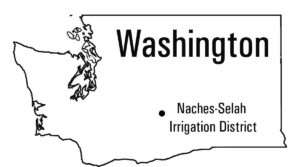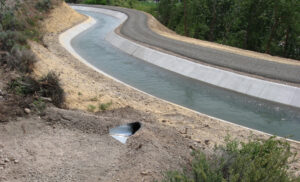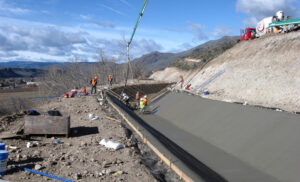The Naches-Selah Irrigation District (NSID) serves around 11,000 acres in the foothills of the eastern slope of the Cascades. Its history dates back to the late 19th century—and in some cases, so does its infrastructure. Up until a few years ago, the NSID had extensive stretches of wood-stave pipes and wood-trestle flumes in its system. Since around 2005, it has made a concerted effort to replace those structures with modern infrastructure made of fiberglass pipe, lined concrete canals, and other materials. In this interview, NSID Manager Justin Harter tells Irrigation Leader about the NSID’s impressive modernization efforts.
Irrigation Leader: Please tell us about your background.
 Justin Harter: I’ve been working for irrigation districts for pretty much my whole career. I’ve been with the NSID since 2005. Prior to that, I was with the South Columbia Basin Irrigation District. I’ve had a rewarding career so far and have done a lot of modernization and improvement of irrigation canals and distribution systems. I also enjoy living in a rural area with ready access to outdoor activities.
Justin Harter: I’ve been working for irrigation districts for pretty much my whole career. I’ve been with the NSID since 2005. Prior to that, I was with the South Columbia Basin Irrigation District. I’ve had a rewarding career so far and have done a lot of modernization and improvement of irrigation canals and distribution systems. I also enjoy living in a rural area with ready access to outdoor activities.
Irrigation Leader: Please tell us about the NSID.
Justin Harter: The NSID is located in northern Yakima County, in Washington State’s Yakima River basin. It adjoins the Naches River, and the main canal flows about 15 miles, serving the foothills of the eastern slope of the Cascades. It’s a great area for tree fruit: A lot of apples, cherries, and pears are grown in the area. Construction on the Selah Valley Canal started in 1888, and it has been flowing since 1892. Many of the families that homesteaded this area have grown into large fruit businesses, corporations, and grower-packer operations, spreading out from the district across the state into other parts of the Northwest. The NSID is a non-Bureau of Reclamation project.
The NSID serves about 11,000 acres, making us smaller than some of the neighboring districts. I call us a big little district: We’re large enough to be complicated and to have a manager who is involved in activities beyond the day-to-day operations of the district. Some of the smaller districts or canal companies are run by just a handful of people. We have eight full-time employees: five in the field and two in the office, plus me.
Irrigation Leader: Would you tell us about the situation when you started and what you’ve done during your time at the NSID?
Justin Harter: In 2005, when I was hired, the board had already achieved a few improvements. By 2005, it had saved up some money by raising assessments and was ready to start in earnest to make improvements to the district. I took on that challenge. We started by replacing some wood pipes that were more than 80 years old. We did some planning exercises with consultants to develop more fine-tuned plans for the district’s future. Based on that, we developed a modernization plan. Since 2005, we have made improvements each year. The 2015 main canal flume replacement and improvement project was part of that. It was probably the biggest project the district’s done in the last 60 years.

Irrigation Leader: For those who are unfamiliar with it, would you tell us how wooden pipe is constructed?
Justin Harter: We have both wood flumes and wood stave pipe. I never thought I’d be working with wood facilities and wood waterworks—the way I explain it is that the district was built with anything that would fit in the back of a horse-drawn wagon. Using carpentry skills, early irrigators built trestle wood flumes to span small ravines, gullies, and canyons in the steep hillsides of our area.
The wood flumes are shaped like a half-circle with a diameter of 9 feet and can move 150 cubic feet of water per second. Interestingly, a 1930s sales manual that we own recommends that there only be 1 inch of freeboard for every foot of diameter, so the wood flumes we had were designed with only 9 inches of freeboard.
The wood staves have small tongues and grooves on their edges, allowing them to be fit together. A cross board with an iron rod band is used to tighten them, making them relatively watertight. Water is an important part of the sealing process, as the wood swells in the spring after drying out over the winter. Wood pipes that are buried in the ground are either wrapped in wire or, in the case of larger-diameter pipes, have individual rod bands that were tightened as the pipes were constructed in place. They’re remarkable facilities. The 1930s sales manual I mentioned states that the products would last 50 years, but we have facilities that were installed in the 1920s and 1930s and are still in service.
Irrigation Leader: How are the wood pipes joined together?
Justin Harter: There are the continuous wood staves, which are the pipes with a diameter of 30 inches or more. Smaller-diameter manufactured wood-stave pipes have machined ends. For lower-pressure pipe joints, that means a wood collar with rod bands clamping around the outside; for higher-pressure pipe, the joint is an iron-steel collar that was driven on by force, probably by manual labor.
Irrigation Leader: Please tell us about the pipes and siphons you used to replace some of these flumes.
Justin Harter: As we came to the final stages of planning in 2013, steel pipe was an option, but I prefer nonferrous, less corrosive options because they do not require you to maintain coatings over the lifetime of the pipe. We looked at high-density polyethylene. Then we looked at centrifugally cast, fiberglass-reinforced polymer water pipe manufactured by HOBAS. HOBAS had more experience installing larger-diameter pipe than its competitors. Ours was not the largest they produce, but it was quite large at 96 inches. HOBAS’s other selling points included the fact that it has a gasketed coupling system for the joints and also allowed for field cutting to length as needed. Working with HOBAS was great. It maintained a good delivery schedule. We had the contractor supply the pipe, so the contractor worked with the company on a $2 million pipe order.

We replaced our elevated wood trestles with siphons. The highest was a 50‑foot trestle that crossed a canyon; the rest were 20–40 feet in height. In other areas, we constructed open-channel, reinforced-concrete canals. We put geomembranes under the concrete to make them watertight, reducing future maintenance needs. We went with IPG’s Aqua Master, which seems to be a good system. The elimination of seepage has saved us water. The concrete structures we replaced were from the 1900s—well over 100 years old—and many were deteriorating heavily, so we definitely got our money’s worth prior to replacement.
Irrigation Leader: What did you replace the 50‑foot trestle with?
Justin Harter: At this site, a canyon interrupted a concrete-lined tunnel system that dates back to the 1930s. A wood flume trestle crossed the canyon, linking the sections of tunnel on either side, with about 1 foot of drop from one tunnel to the next. The wood flume trestle was replaced with a V-shaped siphon that connected to the existing tunnels with concrete inlet and outlet structures. HOBAS supplied a custom-built 96‑inch pipe tee along with two custom elbows that form the bottom section of the siphon. It integrates a manhole and drain access for future maintenance needs. The pressure rating of that pipe is 25 pounds per square inch.
Irrigation Leader: What percentage of water were you losing in your system before these upgrades?
Justin Harter: In some areas, as much as 30 percent. You could see water dripping from the wood facilities with the naked eye, but what was even worse was how much water was being lost in the unlined earth sections. The biggest savings relate to reliability or the risk of failure. In 1992, a wood flume came down. The district was fortunate to reestablish water deliveries within 14 days, but it put a lot of crops at risk. That was really when the district realized that it needed to modernize.
Irrigation Leader: In addition to piping and lining, you have also automated parts of your system, correct?
Justin Harter: Yes. During the modernization, we recognized that a fully automated supervisory control and data acquisition (SCADA) system would be necessary. The biggest lesson I learned from this process was that when you make your operations more efficient and conserve more water, you end up needing automation. Otherwise, you would have to spill the water you saved at the end of the system. In 2007, we installed our first Rubicon gate. We were happy with its performance and the service we received from Rubicon, so we selected the company as our sole source and kept adding gates each year, culminating in 2012, when we installed the last six gates and implemented Rubicon’s Total Channel Control solution. It maintains a pool level—a target level on each reach between the gates—and allows our users to turn their water on and off at will without needing to inform us in detail about their needs. They do give us some notice of their delivery needs, but the automated system doesn’t really require any operator input to respond to the changes in delivery flows and user demands. Today, we have 16 Rubicon flume gates, a slip meter, and a number of monitoring sites, so our SCADA has expanded to comprise 22 remote sites.

Irrigation Leader: How do your farmers order their water?
Justin Harter: We keep it simple. We haven’t modernized that part. They either call or e-mail the office. We’re a senior rightholder and a nonproratable district in the Yakima basin, so we have an earlier order right. This is typical of districts like ours. Instead of having a major volume of delivery, we go off instantaneous flow, and our users are restricted to a certain flow. We still use the antiquated measure known as a miner’s inch. Our miner’s inch is 1/40 of a cubic foot per second, or 11¼ gallons per minute. Based on that, our users’ allotments are roughly equivalent to 5 gallons a minute per acre.
Irrigation Leader: What has the district done with the water it has conserved?
Justin Harter: In the case of grant-assisted projects, the water stays in the river. Most of our saved water is fully funded by landowners and rate payers, so we use it to assure the reliability of our delivery and enhance some of the deliveries that are available. We do have a limited acreage that we can serve with our water rights, so we are focusing on better serving the users rather than expanding acreage.
Irrigation Leader: What percent of your district’s facilities have been completely modernized?
Justin Harter: Probably around 40 percent, by flow of water. About 3,000 of our 11,000 acres have modernized service. Improvements have been made to the rest of the system, but not quite to our full plan. The project is ongoing.
We have paid a couple million dollars down on the bonds we took out in 2014 and 2015. After taking out those loans, we had a total of over $9 million in bonds and loan debt; now, we’re down to under $7 million. It takes time to pay things off. Right now, bond rates are remarkably low—some recent ones are under 2 percent—so we’re looking to refinance or refund our existing bonds. We are also looking at financing our other outstanding needs. We still have about a mile of wood flumes on one of our laterals. They’re about 5 feet in diameter—about half the size of the main canal flumes we replaced—and no younger. That’s a $10–$12 million project. We originally set up 4 miles of lateral, and we’ve got another 2½ miles of improvements, which will probably cost another $10 million. In total, the next round of modernization will cost around $22 million, and that still doesn’t fully complete our modernization plan.
Irrigation Leader: What advice do you have for other managers and irrigation district board members about modernizing their facilities?

Justin Harter: The old ways work—I usually say our canals are operating on 2,000‑year-old technology and haven’t changed much in the last 80 years for a reason. However, farms have embraced new technology and methods and have become more efficient, which means that it’s getting tougher to serve the farms’ demands. We’re trying to play catch up in terms of efficiency. As a manager or board member, you need to be concerned with what happens tomorrow while planning for the next century.
Justin Harter is the general manager of the Naches-Selah Irrigation District. He can be contacted at justinh@n-sid.org.
